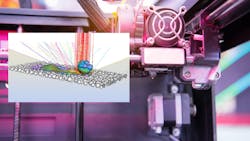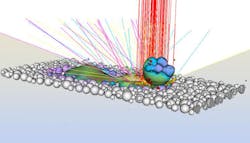Laser Scan Adjustment Eliminates Defects in 3D-Printed Metal Parts
The most popular 3D printing process for making metal parts is laser powder-bed fusion (LPBF). It uses a laser beam to scan 2D patterns over a flat bed of powdered metal to form melt tracks that fuse with the lower layers. This 2D process is repeated thousands of times to create 3D objects. Despite its apparent simplicity, the process still faces challenges. For example, the same LPBF machine, using the same powder and parameters, can generate parts with varying quality. One common set of defects involves pores and other surface blemishes.
To better understand the problem associated with LPBF parts, engineers at Lawrence Livermore National Laboratory used computer models to create a “digital twin” of the process. Then they performed a host of virtual experiments on builds at the microscale level using the digital twin. They discovered that some of the defects were being caused by spatter, small metal particles blasted from the surface of the melted powder bed by the force of the laser.
By comparing the simulations to experimental data captured using high-speed X-ray and optical imaging of LPBFs in action, researchers eventually devised a stability criterion resulting in a “power map.” The power map gives user a strategy that adjusts the laser’s power output along the laser track to stabilize the melt pool and avoid spatter.
When used, the strategy reduces or eliminate pores, keyholes (a deep and narrow melt pool) and other below-the-surface phenomena that can cause defects.
Another “trick” the researchers learned is that pre-sintering the metal powder—running a multibeam laser over the powder at a low power to fuse the particles together prior to the build—reduces spatter and minimize the “snowballing effect,” where large spatter accumulates on the powder bed and becomes difficult to get rid of. Researchers says the strategy will improve overall part reliability and spur wider adoption of 3D printing.
Another problem the team identified is called “laser shadowing,” in which melted metal powder blocks or eclipses the laser. Shadowing creates a sudden decrease in the melt pool depth, which can create pores in the melt pool; the larger the spatter, the more shadowing that results. The team also discovered a phenomenon of “self-replication,” where the laser hits a large pile of spatter on the powder bed and splits it, causing additional spatter sites and creating a snowball effect.
The laser’s intensity is good for expelling spatter that could block the laser, according to Saad Khairallah, a computational physicist at LLNL. But if the laser’s power is ramped up too quickly, or is too high, it can create large back spatter and keyholes. The power map the researchers devised dynamically adjusts laser power along the track, finding a “sweet spot” that can keep the melt pool stable, expels spatter that blocks or shadows the laser, and prevent spatter from becoming too large.
“With our map, you can devise new scan strategies or adapt existing ones that maintain stability to prevent pores and defects,” Khairallah explains. “In the future, someone could simulate scan strategies to determine the best power level to use along the scan track. If you’re doing a spiral or complex geometry, where heat doesn’t dissipate quickly, it will tell you how to adjust the power at these bottleneck regions.”
As Khairallah notes, spatter is the enemy of building nice parts. “It’s not just small particles flying around—they can create spatter that affects the build in different ways and scenarios,” he says. “People can’t just naively turn on their lasers and start scanning, because the wrong scan strategy can create spatter at the start of a track, beyond a size threshold, that can be bad for the build.
“The good news,” Khairallah adds, “is that using this stability criteria lets users modify scan strategies based on a controlled power map they apply to prevent much of the back-spatter.”

